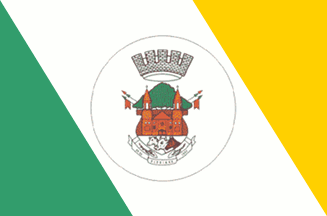 image by Dirk Schönberger,
15
February 2012
image by Dirk Schönberger,
15
February 2012Source: http://www.glorinha.rs.gov.br/glorinha_rs

Last modified: 2012-03-28 by ian macdonald
Keywords: rio grande do sul | glorinha |
Links: FOTW homepage |
search |
disclaimer and copyright |
write us |
mirrors
 image by Dirk Schönberger,
15
February 2012
image by Dirk Schönberger,
15
February 2012
Source:
http://www.glorinha.rs.gov.br/glorinha_rs
A north-south descending diagonal tricolour, green-white-deep yellow with the municipal arms in the centre in a black ring.
Official website at
http://www.glorinha.rs.gov.br/glorinha_rs
Dirk Schönberger,
15 February 2012
The municipality of Glorinha (6,885 inhabitants in 2010; 192 sq. km) is located in the Porto Alegre Metropolitan Area, 50 km of Porto Alegre. Glorinha originates in the division of the municipality of Gravataí in 1834 in the districts of Costa da Sapucaia, Freguesia de Aldeia dos Anjos and Passo Grande, the latter being subsequently known as Rua da Glória. The "street" ("rua"), indeed a path, was lined with house forming a small village settled by colonists of Portuguese origin. The original chapel dedicated to Our Lady of Glory ("Glória") was rebuilt in 1906 as a parish church. Rua da Glória was then a busy place, being the only access to the northern coast of Rio Grande do Sul from Porto Alegre. Around 1910, the settlement was renamed Glorinha, for its patron saint. In 1936, the first macadamized street in the State (RS-030) linked Glorinha to Passo Grande. In the 1960s, Glorinha became the main milk producer in Rio Grande do Sul. The municipality of Glorinha was established by State Law No. 8,590 of 4 May 1988.
The symbols of Glorinha are prescribed by Municipal Law No. 103 of 23
April 1992.
The flag uses the official colors of the municipality, in their
"regular" shades:
- Green represents the preserved natural environment, the fields and
the forests;
- White represents quietness, faith and hope;
- Yellow represents the fields generating richness and prosperity.
The coat of arms is shaped like a mate-drinking gourd, brown in its main part and white in base. It includes: - the main facade of the parish church, in brown and orange, covering most of the upper part of the shield; - three cattle's head in the base: a white sheep, a gray bovine and a brown horse, all outlined in black on a white background. Moreover, the coat of arms includes: - the canopy of a green fig-tree; - four white spears issuing from the base of the fig-tree, the two upper ending with two finials, green and orange, the two lower ending with a green finial and supporting an orange pennant; - a gray mural crown above the shield; - a three-part gray scroll inscribed "04-05 GLORINHA 1988" placed below the shield and tied to it by the points; - rice stems placed between the shield and the scroll, two on each side.
The gourd-shaped shield represents hospitality.
The mural crown and the spears represents sovereignty and protection.
The church recalls the Christian origin of the inhabitants.
The fig-tree is a main feature of the downtown.
Cattle and rice are the main products.
The scroll is inscribed with the date of establishment of the
municipality.
http://www.glorinha.rs.gov.br/glorinha_rs/index.php?option=com_content&view=article&id=48&Itemid=56
http://www.glorinha.rs.gov.br/glorinha_rs/images/galeria/im_11.jpg - Photo, municipal website
http://www.glorinha.rs.gov.br/glorinha_rs/images/galeria/im_4.jpg - Photo, municipal website
Ivan Sache, 24 March 2012